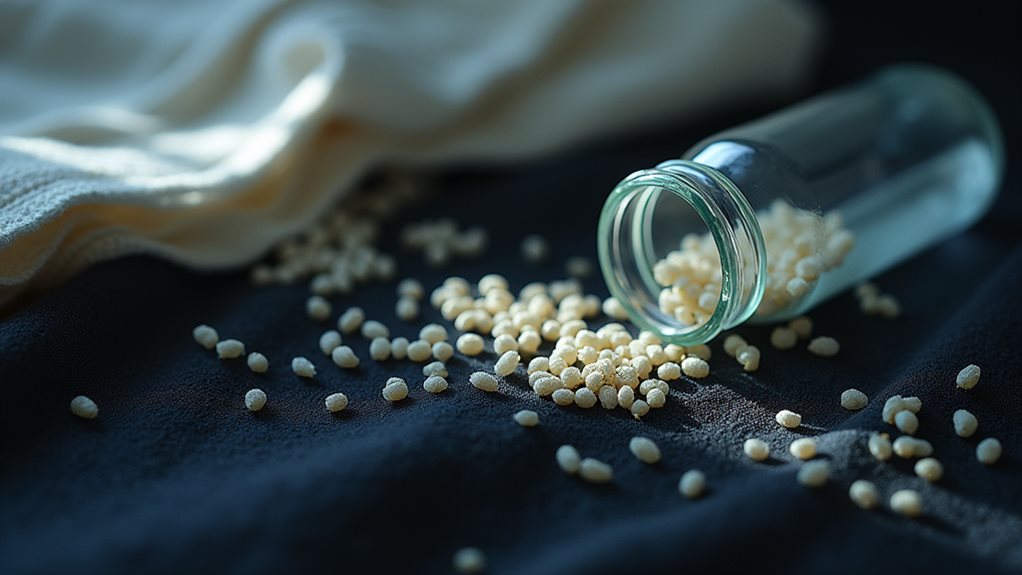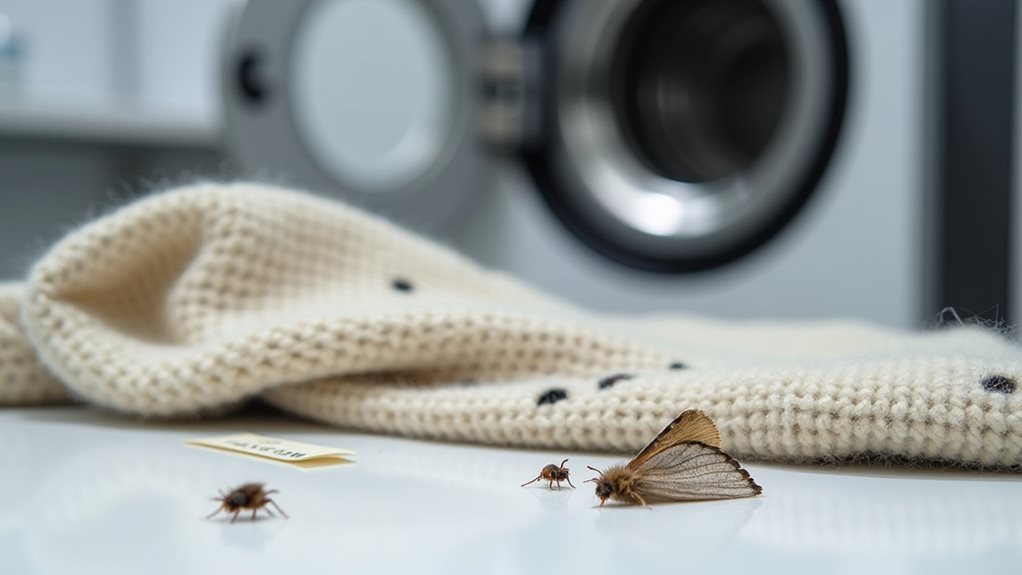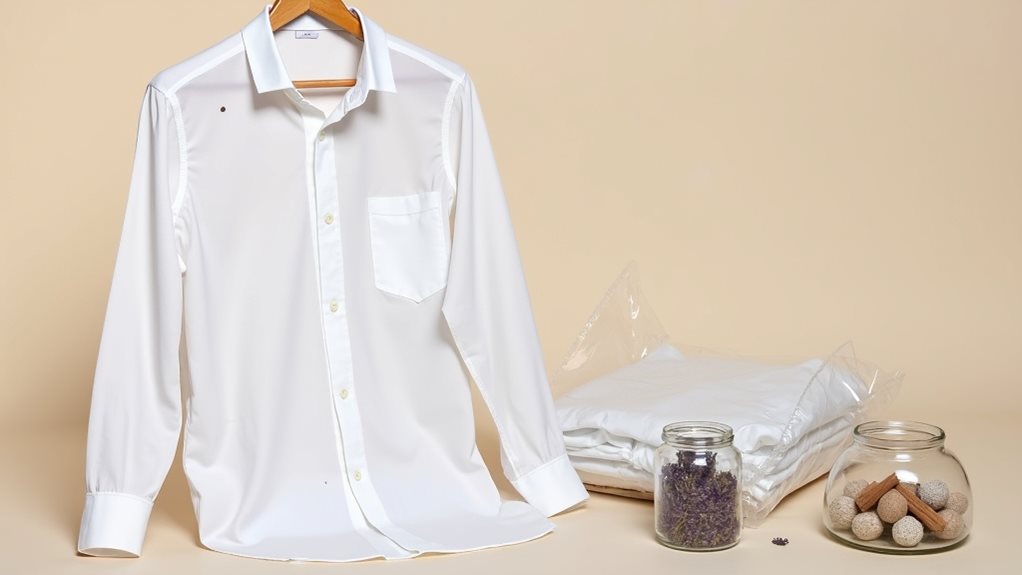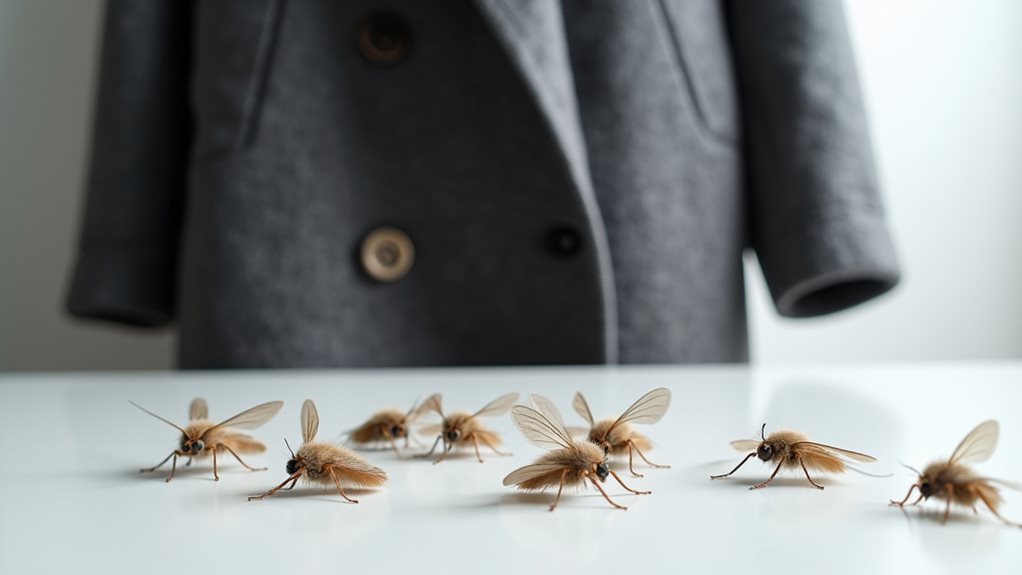You’ll be relieved to know that dry cleaning absolutely kills moths, their larvae, and eggs through a powerful one-two punch of chemical solvents and intense heat reaching 140-160°F. The process penetrates every fiber where these fabric-munching pests love to hide, while chemicals like PERC dissolve protective coatings around eggs, fundamentally suffocating them. It’s particularly effective for delicate woolens that can’t handle hot water washing, and when you explore the complete treatment approach, you’ll discover even more protective strategies.
How Dry Cleaning Eliminates Moths and Their Larvae
While discovering moth holes in my favorite cashmere sweater felt like finding tiny heartbreaks scattered across fabric, I learned that dry cleaning can be your most powerful ally in this battle against these fabric-loving invaders.
When you take woolens to a professional dry cleaning service, the chemical solvents combined with high temperatures above 120°F create a lethal environment that’ll kill moth larvae hiding in those cozy natural fibers.
The process doesn’t just thoroughly clean your garments—it penetrates every fiber where larvae and eggs might be lurking, waiting to cause more moth damage.
Regular dry cleaning helps prevent moths from establishing a clothes moth infestation by eliminating the oils and stains that attract these unwelcome guests.
The perchloroethylene and other cleaning solvents used in professional dry cleaning are toxic to moths at all life stages, making this treatment more reliable than home washing methods where moths can sometimes survive lower water temperatures.
Effectiveness of Dry Cleaning Solvents Against Moth Eggs

The real magic happens when those powerful dry cleaning solvents, particularly perchloroethylene (PERC), go to work on moth eggs that might’ve survived your initial panic-cleaning session.
The real magic unfolds when industrial-strength PERC solvents hunt down those stubborn moth eggs hiding in your fabric’s deepest fibers.
This stuff doesn’t mess around – it penetrates deep into fabric fibers where sneaky moth eggs love to hide, dissolving organic materials that would otherwise become your favorite sweater’s downfall.
Here’s why dry cleaning solvents are so brutally effective against these tiny troublemakers:
- Chemical warfare: PERC dissolves the protective coating around moth eggs, fundamentally suffocating them before they hatch.
- High temperatures: The process combines heat with chemical action, creating a double-whammy that moth larvae simply can’t survive.
- Deep penetration: Unlike home washing, these solvents reach every fiber, guaranteeing no infested garments escape treatment.
You’re basically giving those moths the ultimate eviction notice! 🦋
However, many dry cleaning facilities are now switching to safer alternatives like wet cleaning, liquid CO2, and hydrocarbon solvents that can be just as effective against moth problems while reducing health concerns.
Comparing Dry Cleaning to Other Moth Treatment Methods

When you’re battling moths in your favorite sweater, you’ve got several weapons in your arsenal, and honestly, I’ve tried them all after discovering holes in my grandmother’s vintage cardigan.
You can toss items in the washing machine with scalding hot water, freeze them for days like some kind of textile popsicle, or take the professional route with dry cleaning.
Each method has its strengths and quirks, but understanding when to use which approach can save you both heartache and money, especially when you’re dealing with delicate fabrics that cost more than your monthly coffee budget ☕.
The high heat used in dry cleaning processes typically reaches 140-160°F, which can effectively eliminate moths and their eggs when fabrics are exposed to these temperatures for sufficient time.
Dry Cleaning Vs Washing
Several treatment options exist for eliminating moths from your wardrobe, and honestly, I learned this the hard way after discovering tiny holes in my favorite cashmere sweater last winter 😅.
When comparing cleaning methods for thorough pest eradication, you’ll find each approach has distinct advantages for targeting clothes moth larvae and infestations.
Here’s what works best for different situations:
- Dry cleaning – Perfect for valuable clothing and delicate fabrics, as solvents penetrate deeply to kill moths at all lifecycle stages.
- Hot water washing – Effective at temperatures over 120°F, but risks damaging sensitive materials like silk or wool.
- Deep freezing – Requires two weeks at -18°C, making it impractical for immediate needs.
Dry cleaning consistently delivers superior results because it reaches deeper fabric layers where washing might miss hidden larvae. The high heat used in professional dry cleaning processes, typically reaching 140°F or higher, creates lethal conditions for fabric pests at all developmental stages.
Alternative Treatment Methods
Although dry cleaning stands as the gold standard for moth elimination, exploring other treatment methods helped me understand why different approaches work better for specific situations, and honestly, some of these alternatives surprised me with their effectiveness.
Freezing garments at -18°C for 72 hours became my go-to alternative treatment when I couldn’t afford professional cleaning, and while it doesn’t use chemical solvents, it’ll kill moth larvae and eggs just as effectively.
Steaming works decently for surface-level problems, though I’ve learned it won’t penetrate thick fabrics where stubborn larvae hide.
When facing a serious infestation, I still recommend dry cleaning because those powerful chemicals reach every fiber, but these alternatives can definitely help you manage smaller problems without breaking the bank! 🧊
Similar to how dry cleaning uses high heat exposure to eliminate bed bugs and their eggs, the same thermal principle makes it highly effective against moth infestations in delicate fabrics.
When to Choose Dry Cleaning for Moth-Infested Garments

If you’ve discovered those telltale holes in your favorite cashmere sweater, like I did last winter when I pulled out my grandmother’s vintage coat only to find it looked like Swiss cheese, you’re probably wondering whether dry cleaning can save your remaining wardrobe.
The good news is that dry cleaning’s chemical solvents provide thorough eradication of clothes moths at every life stage, making it your best friend when dealing with infested garments.
Choose dry cleaning when you’re facing these situations:
- Delicate fabrics that can’t handle hot water washing (above 120°F) but need pest elimination
- Wool items requiring regular treatment to kill moth larvae and eggs after wearing
- All garments stored in infested areas, even seemingly untouched pieces
Similar to how dry cleaning chemical solvents like perchloroethylene can eliminate various pests and organisms from fabrics, the process effectively targets moths and their offspring hiding in your clothing fibers.
Trust me, it’s worth the investment.
Preventing Reinfestation After Dry Cleaning Treatment

You’ve successfully eliminated those pesky moths through dry cleaning, but here’s the thing I learned the hard way after my favorite cashmere sweater got re-infested just weeks later – the real battle begins when you bring those clothes back home.
Think of it like this: you wouldn’t leave your front door wide open after fumigating your house for ants, right? That’s exactly why you need rock-solid storage methods and a monitoring system that’ll catch any sneaky survivors before they can throw another moth party in your closet 🦋.
Proper Storage Methods
- Choose the right protection: Store items in airtight containers or breathable garment bags that create barriers against moth activity.
- Clean everything thoroughly: Confirm garments are spotless before storage, since food stains attract egg-laying females.
- Monitor consistently: Regularly inspect stored items and use pheromone traps to prevent reinfestation.
Remember that dry cleaning should be viewed as one component of a comprehensive elimination strategy that includes proper storage protocols and ongoing vigilance to ensure long-term protection against moths.
Ongoing Monitoring Practices
While dry cleaning effectively eliminates existing moths and their larvae, your vigilance in the weeks and months that follow determines whether you’ll maintain that hard-won victory or find yourself back at square one.
Think of yourself as a detective on patrol – regularly inspect your clothing for telltale holes or webbing that signal unwelcome visitors have returned.
Store those freshly treated garments from the dry cleaner in airtight containers or breathable bags, creating an impenetrable fortress against future invaders.
Set up pheromone traps in your closets to catch adult male moths before they can start their reproductive shenanigans 😏.
Keep your clean storage areas spotless through frequent vacuuming, especially those sneaky corners where moths love to hide, because preventing reinfestation requires consistent effort.
Pay special attention to delicate fabrics like silk, wool, and cashmere during your inspections, as these materials remain prime targets for moths even after professional cleaning treatment.
Cost Considerations and Professional Pest Control Alternatives

When you’re facing a moth infestation, the financial reality hits harder than finding your favorite cashmere sweater riddled with holes – dry cleaning costs can quickly spiral from $25 to $100 for multiple garments, which means you’ll need to be strategic about what gets the professional treatment.
Here’s your smart approach to balancing cost with effectiveness:
- Reserve dry cleaning for high-value clothing like wool coats, silk blouses, and delicate fabrics that moths love most.
- Consider professional pest control for severe infestations that require extensive solutions targeting your entire environment.
- Combine both methods strategically – dry clean precious items while pest control experts handle larvae hiding in carpets and closets.
Professional pest control services offer broader environmental treatment that dry cleaning alone can’t match, helping prevent future occurrences throughout your home’s vulnerable spaces. While dry cleaning uses high heat exposure that can effectively kill moths and their eggs, it should be viewed as a supplementary treatment rather than your primary pest elimination strategy.




